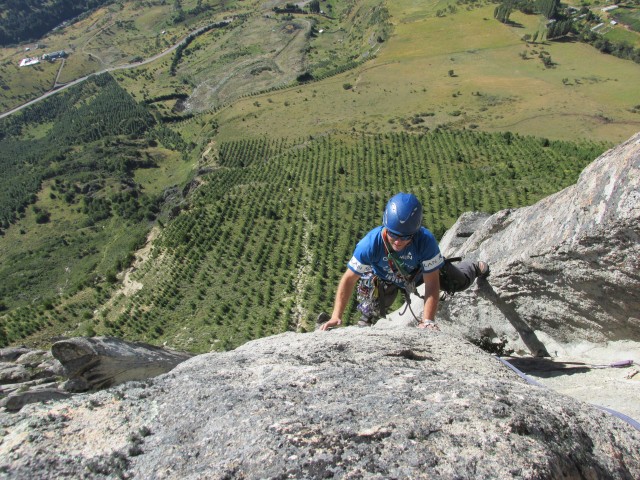The steep, hot, unshaded hillside was untrailed, but at least it was covered in pimpenellas, a dry seed with burr like tendencies that got all over clothing, skin and hair. The young, exotic pine trees planted in rows provided no shade and for the most part just funneled us straight up or sideways. “Man this had better be a good route” Rodrigo said in his broken, accented English. We had just spent thirty minutes being shown around the elderly landowner’s workshop and yard and were just anxious to get climbing. I could not have agreed more. While I was excited to sample some more of Coyhaique’s rock, the handful of other multipitch routes made me doubt the approach’s worthiness. “I am sorry about this” he continued.
“Don’t apologize yet” I replied, not wanting him to feel bad. Above us rose a couple hundred meters of white, columnular basalt, stretching for several hundred meters across the hillside. We mostly walked in silence though, with the exception of the occasional “que mierda” and “chucha” cursing of the annoying seeds that would stick to our clothing and irritate our skin.
The photocopied .pdf guide vaguely showed a few pitches on a black and white picture. A couple anchors and a couple bolts. After about 25 or 30 minutes of walking we reached the base. Scrubby calafate bushes and the vibrant machay along with similar looking lavender flowers replaced the pimpenella and we sidehilled to the west, looking for potential identifying features.
Rodrigo pointed out some anchors up high. Thirty feet off the ground a dihedral split the textured grey rock, but there was little indication of past passage up to the crack. We poked around, noted that the guia de libro indicated a sixty meter first pitch and decided it was worth a go. Besides, we saw nothing else. I dropped my pack, chugged most of my water and racked up.

I started by climbing steep, slick shrubbery covered ground for 5 meters, which while not good at least gave me a slow down if and when, after my first three shitty pieces of gear pulled, would give the ground the effect of a runaway truck ramp. A bit of stemming in a slabby corner led to a poor nut placement and then more stemming in more of the same, led to more of the same gear placements. I hemmed and hawwed, then sucked it up and went for it, taking advantage of a Sinks Canyon like pocket for a far stem with my right foot. A few vegetable belays and a bad cam in chossy rock later and I was on a good ledge with a handcrack dihedral leaving it. Upwards. When the protection ran out and the hot summer sun melted the crack into a series of deep, incut, solid pockets, I marveled at the quality of the stone. Despite the buckets, solid feet, and not too steep angle, the sparse protection on 5.7 terrain made for a slow lead. I worked my way up to a corner, then a face traverse left. Two equalized #4 nuts, a blue alien, and an orange TCU combined to protect the last 30 meters or so. “Man, I think that is the longest pitch I ever climb in my life” Rodrigo proclaims as he reaches the semi hanging, two bolt belay. I concur, adding that is also one of the better long pitches I have climbed.
The penultimate pitch was another long one that sported similar runouts but those 55 meters required a bit more guess work on the route finding and required more challenging climbing. When I finally stemmed and smeared my way up the last ten meters I once again found myself grateful that I did not have to lead that section. These two pitches, unlike Escudo, both sported solid rock. Not having to think that the hold was going to break off while engaged in a healthy runnout was a good feeling. And unlike Salto Chico, these pitches were long. So far, I though to myself, the arduous approach had been worth it.
A short move right started the last pitch. After the initial traverse the climbing turned upward into a wide V-slot chimney, which I negotiated with the time honored techniques of grunting and struggling. The chimney faded into a shallow corner crack. It may have been thin, eating all my #00, 0, 1 TCUs, and blue aliens, with difficult climbing, but at least the rock quality deteriorated with each upward move. Combining those factors really allowed me to focus on my breathing, trusting feet and crimps on flaky slabs, and not saying take because I wasn’t sure the gear would hold. Unfortunately it not being a rope stretcher and there being a decent bolt somewhere on the pitch did not let me test myself completely. The angle kicked back a touch at the top and straight in .5 Camalot in hollow, flaky rock provided the security I needed to hoof it up to the belay. I stood at a decent stance and clipped the bolt. I reached around my harness, detached my water bottle and chugged a few seconds worth of water.

“Belay off” I yelled down to Rodrigo after building the anchor and clipping in. “Yep, probably the best route I’ve done round here” I say when he eventually approaches the anchor.
“Yes, nice lead” he says.
“Not so much the third pitch though” I reply. “The rock quality really deteriorated.” Rodrigo reaches the belay and puts up his right hand in the universal high-five request. “Yeah, I would recommend the first two pitches” I continue as we trade palm sweat, “but I am not so certain about this here third one.” I offer him my remaining water as he nods in agreement. “I guess it was worth the pimpenellas, though. Can’t wait to pick more off my on the hike down.”

Be First to Comment